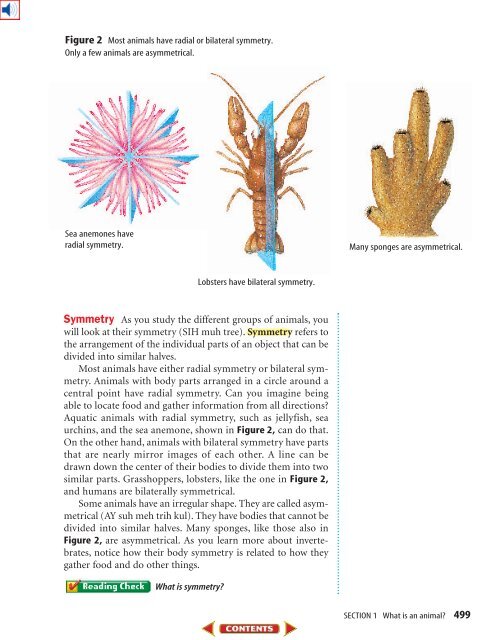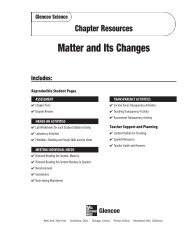Chapter 17: Invertebrate Animals
Chapter 17: Invertebrate Animals
Chapter 17: Invertebrate Animals
You also want an ePaper? Increase the reach of your titles
YUMPU automatically turns print PDFs into web optimized ePapers that Google loves.
Figure 2 Most animals have radial or bilateral symmetry.<br />
Only a few animals are asymmetrical.<br />
Sea anemones have<br />
radial symmetry.<br />
Many sponges are asymmetrical.<br />
Lobsters have bilateral symmetry.<br />
Symmetry As you study the different groups of animals, you<br />
will look at their symmetry (SIH muh tree). Symmetry refers to<br />
the arrangement of the individual parts of an object that can be<br />
divided into similar halves.<br />
Most animals have either radial symmetry or bilateral symmetry.<br />
<strong>Animals</strong> with body parts arranged in a circle around a<br />
central point have radial symmetry. Can you imagine being<br />
able to locate food and gather information from all directions<br />
Aquatic animals with radial symmetry, such as jellyfish, sea<br />
urchins, and the sea anemone, shown in Figure 2, can do that.<br />
On the other hand, animals with bilateral symmetry have parts<br />
that are nearly mirror images of each other. A line can be<br />
drawn down the center of their bodies to divide them into two<br />
similar parts. Grasshoppers, lobsters, like the one in Figure 2,<br />
and humans are bilaterally symmetrical.<br />
Some animals have an irregular shape. They are called asymmetrical<br />
(AY suh meh trih kul). They have bodies that cannot be<br />
divided into similar halves. Many sponges, like those also in<br />
Figure 2, are asymmetrical. As you learn more about invertebrates,<br />
notice how their body symmetry is related to how they<br />
gather food and do other things.<br />
What is symmetry<br />
SECTION 1 What is an animal 499














